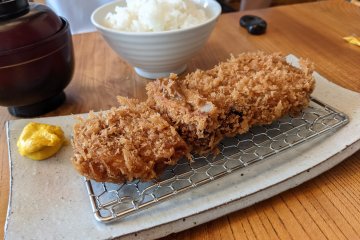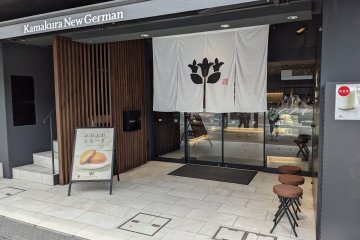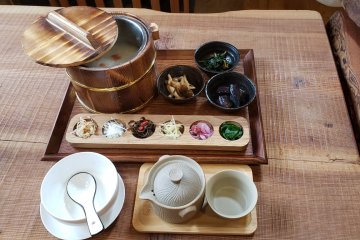
하야마 "SCAPES"에서의 런치
Tomoko Kamishima정말 맛있는 야채, 맛있는 스테이크와 디저트, 세련된 분위기와 놀라운 광경을 즐기고 싶다면 "SCAPES"라는 식당은 딱 여러분을 위한 곳이다.

창의적인 프렌치 레스토랑인 Nature et Sens에서 감각적인 경험을 마음껏 즐길 수 있습니다. 제철 식재료와 가마쿠라 농산물은 이 절묘한 요리에서 가장 중요한 위치를 차지합니다. 식사 중에 다양한 와인 컬렉션에서 선택해서 와인과 미식을 즐기세요.

정말 맛있는 야채, 맛있는 스테이크와 디저트, 세련된 분위기와 놀라운 광경을 즐기고 싶다면 "SCAPES"라는 식당은 딱 여러분을 위한 곳이다.

아라타마 명물 돈가스를 맛본 후에는 이 신선한 맛에 반하게 될 것입니다. 돈까스 외에도 다양한 선택을 제공합니다. 모짜렐라 치즈 고로케, 크림 고로케 등 아라타마의 다른 요리도 꼭 드셔보세요.

지역 주민들이 사랑하는 가마쿠라의 맛을 만나보세요. 가마쿠라 뉴 저멘의 부드럽고 크림 같은 스폰지 케이크가 감동입니다. 특히 카라멜 커스터드는 관광객들에게 가장 인기가 높다.

Ki to Toki는 동물성 없는 제품, 현미, 신선한 현지산 야채를 사용하여 맛있을 뿐만 아니라 눈도 즐겁게 하는 훌륭한 채식 요리를 만듭니다. 17가지 다양한 요리와 발효 음료, 그리고 식후의 디조트, 허브티 또는 커피도 함께 꼭 맛보세요.

Tsurugaoka Hachimangu Shrine is arguably the most important shrine in Kamakura and is located roughly in the center of the city. The shrine was originally founded in 1063 by Minamoto Yoriyoshi, the head of Japan’s Minamoto Clan, and was later moved in 1180 to its current location by Minamoto Yoritomo, the founder and first shogun of the Kamakura shogunate. This relocation marked the start of samurai society and Kamakura as a spiritual and social center of Japan. This rich history and culture is still present in Kamakura today. The shrine is dedicated to Hachiman, the guardian deity of samurai and the Minamoto Clan. Hachiman is worshiped for good fortune in warfare. The long pathway to the shrine runs through Kamakura City and is marked by multiple red torii gates, showing an interconnectedness between spirituality and urban life. Upon entering the shrine grounds, you will see two ponds on either side of you. The pond on the left represents the Minamoto clan, and the one on the right represents the Taira Clan (Minamoto’s rival). The Taira pond purposefully has four islands in it, which symbolizes the bad blood between the clans as four can be pronounced the same as “death” in Japanese. Beside the Minamoto pond is a beautiful peony garden that is open in winter and spring when the flowers are in full bloom. Past the ponds you will come across the mai-den, which is located at the base of the stairs to the main hall. This vibrant red building is used as a stage for music and dance performances throughout the year’s festivities. Atop the wide staircase is the main hall. This traditionally designed structure features a red facade with gold-and-green detailing and is a commanding sight due to its massive size. Beside the main hall is a treasure hall that displays historical artifacts such as swords and masks. The grounds are also home to numerous smaller buildings and shrines, most notably Wakamiya and Maruyama Inari Shrine, which, along with the main hall, are nationally important cultural properties. Tsurugaoka Hachimangu hosts numerous events throughout the year. One of the shrine’s most popular festivals occurs from September 14th to 16th and features yabusame horseback archery. The shrine is also one of Japan’s most popular spots for hatsumode, which is the first shrine visit of the year.

Kamakura-gū is a shrine in Kamakura, Kanagawa Prefecture, Japan. It was erected by Emperor Meiji in 1869 to enshrine the spirit of Prince Morinaga, who was imprisoned and later executed where the shrine now stands in 1335 by order of Ashikaga Tadayoshi. [Wikipedia]

Kenchoji is Kamakura’s oldest Zen temple and is recognized as the top temple of the city’s Five Great Zen Temples. It was originally founded by regent Hojo Tokiyori in 1253 as a Zen training temple, and its first head priest was a Chinese Zen priest named Rankei Doryu. One of Kenchoji’s defining characteristics is its expansive temple grounds. After the gates and main area, the complex extends deep into the wooded hills. The temple’s main buildings feature traditional Chinese architecture and are arranged in a line, which is characteristic of Chinese Zen Buddhist temples. Kenchoji’s entrance is marked by Somon, a relatively small, yet beautiful, wooden gate that leads to the main gate, Sanmon. This massive wooden structure is meant to relieve you of all your attachments. Just past Sanmon and to the right is the temple’s bell tower, and to the left is a revered juniper tree. This 13-meter-tall tree is estimated to be about 760 years old and allegedly sprouted from seeds brought from China during the temple’s construction. After the gates, the temple buildings stand in a line down the complex. First is Butsuden (Buddha Hall), which enshrines the principal statue of the temple, Jizo Bodhisattva. Directly behind Butsuden is Hatto, the largest wooden temple building in Eastern Japan. When Kenchoji was strictly a training temple, monks would gather in Hatto to listen to priests’ lectures. Inside Hatto is a statue of Senju Kannon and a stunning ceiling painting of a dragon among the clouds. Past Hatto is Hojo; this building was initially the head priest’s residence, but today is popular for its picturesque Zen garden. Sanmon, the bell tower, Butsuden, and Hatto are all designated as National Important Cultural Properties. After the main temple grounds, a path goes further into the forested hillside to Hansobo. This small shrine is dedicated to Hansobo Daigongen, the guardian deity of the temple, and has a small observation deck. A little further past the shrine is a second observation deck where you can observe Mount Fuji on clear days. From this point, there is a one-hour hiking trail that leads to Zuisenji Temple.